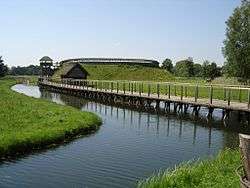Grad
Grad may refer to:
Geometry and measurement
Education related events and ceremonies
People
Companies
Military weapons
Music & gaming
Places
Grads (disambiguation)
Grads may refer to:
Grad (toponymy)
Grad (Cyrillic: Град) is an Old Slavic word meaning "town", "city", "castle" or "fortified settlement". Initially present in all related languages as Gord (archaeology), it can still be found as "grad", or as Horod or Gorod (toponymy) in many placenames today.
These places have grad as part of their name:

Gord (archaeology)
A gord is a medieval Slavonic fortified settlement, also occasionally known as a burgwall or Slavic burgwall after the German term for such sites. The ancient peoples were known for building wooden fortified settlements. The reconstructed Centum-satem isogloss word for such a settlement is g'herdh, gordъ, related to the Germanic *gard and *gart (as in Stuttgart etc.). This Proto-Slavic word (*gordъ) for town or city, later differentiated into grad (Cyrillic: град), gard,gorod (Cyrillic: город), etc.
Similar strongholds were built during the late Bronze and early Iron Ages by the Lusatian culture (ca. 1300 BC – 500 BC), and later in the 7th - 8th centuries BC in modern-day Russia, Belarus, Ukraine, Poland, Slovakia, Czech Republic and eastern Germany. These settlements were usually founded on strategic sites such as hills, riverbanks, lake islands or peninsulas.
A typical gord was a group of wooden houses, built either in rows or in circles, surrounded by one or more rings of walls made of earth and wood, a palisade and/or moats. Some gords were ring-shaped, with a round, oval or occasionally polygonal fence or wall surrounding a hollow. Others, built on a natural hill or a man-made mound, were cone-shaped. Those with a natural defense on one side, such as a river or lake, were usually horseshoe-shaped.

Mandrill
The mandrill (Mandrillus sphinx) is a primate of the Old World monkey (Cercopithecidae) family. It is one of two species assigned to the genus Mandrillus, along with the drill. Both the mandrill and the drill were once classified as baboons in the genus Papio, but they now have their own genus, Mandrillus. Although they look superficially like baboons, they are more closely related to Cerocebus mangabeys. Mandrills are found in southern Cameroon, Gabon, Equatorial Guinea, and Congo. Mandrills mostly live in tropical rainforests. They live in very large groups. Mandrills have an omnivorous diet consisting mostly of fruits and insects. Their mating season peaks in July to September, with a corresponding birth peak in December to April.
Mandrills are the world's largest monkeys. Charles Darwin wrote in The Descent of Man that "no other member in the whole class of mammals is coloured in so extraordinary a manner as the adult male mandrill's". The mandrill is classified as vulnerable by IUCN.

Mandrill (album)
Mandrill is the debut album by Brooklyn, New York based band Mandrill released in 1971. The album peaked at number twenty-seven on the Billboard R&B albums chart.
Track listing
Personnel
Charts
Singles
References
External links

Mandrill (comics)
Mandrill is a fictional character, a mutant supervillain appearing in American comic books published by Marvel Comics.
Publication history
Mandrill first appeared in Shanna the She-Devil #4. He was created by writer Carole Seuling and artist Ross Andru. Steve Gerber dialogued his first appearance and wrote several subsequent appearances, but denied having a hand in the character's creation, saying he was all Seuling's.
Fictional character biography
Jerome Beechman was the son of Frederic Beechman, a physicist at Los Alamos National Laboratory in New Mexico, and Margaret Beechman. Before conceiving his son, an explosion breached the facility's nuclear reactor, bombarding Frederic and a cleaning woman with radiation. When Jerome was born a year later, he possessed black skin (despite both of his parents being Caucasian) and tufts of body hair. Jerome was despised by his family because of his freakish appearance, and when he was ten his father drove him out into the New Mexico desert and abandoned him.
Podcasts:

